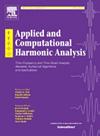度量空间中的流形学习
IF 3.2
2区 数学
Q1 MATHEMATICS, APPLIED
引用次数: 0
摘要
基于拉普拉斯的降维方法是对RN中的数据进行降维的常用方法。这些算法的几个理论结果依赖于这样一个事实,即欧几里得距离局部近似于假定数据所在的底层子流形上的测地线距离。然而,对于某些应用,其他度量,如沃瑟斯坦距离,可能提供比欧几里得距离更合适的距离概念。我们提供了一个将流形学习问题推广到度量空间的框架,并研究了一个度量何时满足图拉普拉斯算子的点向收敛的充分条件。本文章由计算机程序翻译,如有差异,请以英文原文为准。
Manifold learning in metric spaces
Laplacian-based methods are popular for the dimensionality reduction of data lying in . Several theoretical results for these algorithms depend on the fact that the Euclidean distance locally approximates the geodesic distance on the underlying submanifold which the data are assumed to lie on. However, for some applications, other metrics, such as the Wasserstein distance, may provide a more appropriate notion of distance than the Euclidean distance. We provide a framework that generalizes the problem of manifold learning to metric spaces and study when a metric satisfies sufficient conditions for the pointwise convergence of the graph Laplacian.
求助全文
通过发布文献求助,成功后即可免费获取论文全文。
去求助
来源期刊

Applied and Computational Harmonic Analysis
物理-物理:数学物理
CiteScore
5.40
自引率
4.00%
发文量
67
审稿时长
22.9 weeks
期刊介绍:
Applied and Computational Harmonic Analysis (ACHA) is an interdisciplinary journal that publishes high-quality papers in all areas of mathematical sciences related to the applied and computational aspects of harmonic analysis, with special emphasis on innovative theoretical development, methods, and algorithms, for information processing, manipulation, understanding, and so forth. The objectives of the journal are to chronicle the important publications in the rapidly growing field of data representation and analysis, to stimulate research in relevant interdisciplinary areas, and to provide a common link among mathematical, physical, and life scientists, as well as engineers.
 求助内容:
求助内容: 应助结果提醒方式:
应助结果提醒方式:


